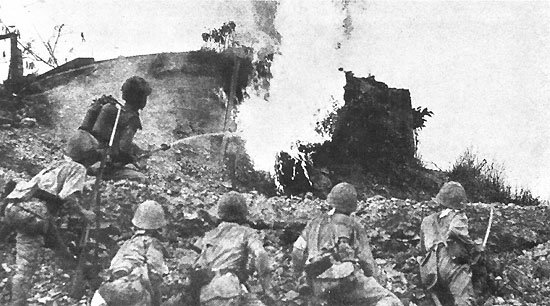
Japanese Marines use flame thrower against American Filipino army bunker in the battle of Bataan 1942.
Japanese forces on Bataan, 1942.
Key battle of the failed American defense of the Philippine Islands between 1941 and 1942. Bataan is a peninsula on the big island of Luzon; it is some 25 miles long and roughly 20 miles wide and extends south into Manila Bay. The peninsula figured prominently in General Douglas MacArthur’s plans for defending the Philippines against a Japanese invasion. The original plan called for U. S. and Philippine forces to withdraw into the Bataan Peninsula and there fight an extended defensive battle until reinforcements arrived from the United States.
MacArthur changed this plan prior to the U. S. entry into the war following the 7 December 1941 attack on Pearl Harbor. He believed that, even with his mobilizing Philippine army and promised reinforcements from the United States, he could defend the entire Philippine Islands against a Japanese invasion. But when elements of Lieutenant General Homma Masaharu’s Fourteenth Army landed at Lingayen Gulf on 22 December, it became apparent that MacArthur’s new plan would not work. Japanese forces quickly broke through MacArthur’s lines north and south of Manila, forcing him to fall back on the original plan but not in orderly fashion. Vast quantities of supplies were lost in the process. By the end of December, more than 67,500 Filipino and 12,500 U. S. troops, as well as 26,000 civilians, were in the Bataan Peninsula. The shortage of supplies put everyone on half rations. Malnutrition, dysentery, and malaria were soon commonplace, with many soldiers unable to fight.
Still, U. S. and Filipino troops put up a stout defense. They lost their main line of defense in late January 1942, but at their secondary line, they stopped Homma’s forces by mid-February. The defenders bravely fought on, halting two battalion-sized Japanese landings in late January and early February.
Meanwhile, most of Homma’s best troops were diverted to the Netherlands East Indies; with more than 2,700 dead, 4,000 wounded, and 13,000 sick, Homma was temporarily unable to mount additional attacks. MacArthur used this pause to shore up his defensive positions, but the realization that no relief force was coming from the United States caused bitter disappointment. The Americans and Filipinos called themselves the “Battling Bastards of Bataan.” And in the wake of U. S. defeats at Pearl Harbor, Guam, and Wake Island, as well as the British defeat at Singapore, the resistance that was mounted in Bataan boosted morale on the American home front.
President Franklin D. Roosevelt ordered MacArthur to leave the Philippines on 11 March, and command of U. S.- Filipino forces fell to Major General Jonathan Wainwright. He inherited a hopeless cause. Homma received reinforcements, and his troops finally broke through the American-Filipino lines on 3 April. MacArthur ordered Wainwright not to surrender, but the U. S. ground forces commander, Major General Edward P. King Jr., realizing that the cause was hopeless, decided to end the fight and capitulated on 9 April.
More than 20,000 Americans and Filipinos perished in the campaign, and roughly 2,000 escaped to the nearby island of Corregidor and fought on until they in turn were forced to surrender on 5 May. The 76,000 prisoners of war of the battle for Bataan-some 64,000 Filipino soldiers and 12,000 Americans-then were forced to endure what came to be known as the Bataan Death March as they were moved into captivity. They had succeeded, however, in delaying the Japanese conquest of the Philippines for 148 days and briefly inspiring the Allied cause during the dark early days of U. S. participation in World War II.
References Mallonée, Richard. Battle for Bataan: An Eyewitness Account. New York: I Books, 2003. Morton, Louis. United States Army in World War II: The War in the Pacific-Fall of the Philippines. Washington, DC: Office of the Chief of Military History, Department of the Army, 1953. Whitman, John W. Bataan: Our Last Ditch-The Bataan Campaign, 1942. New York: Hippocrene Books, 1990.